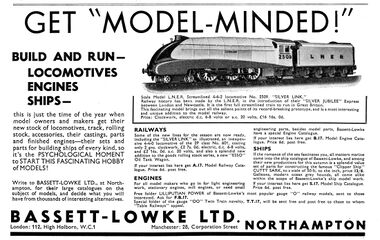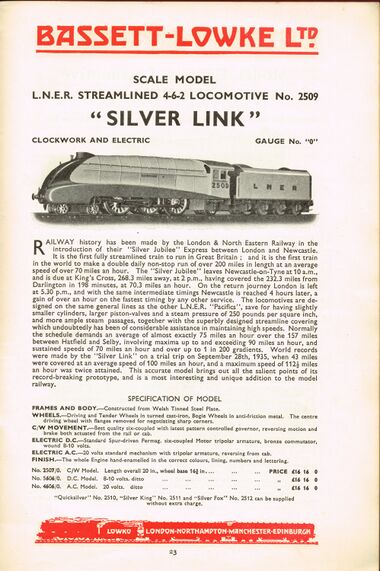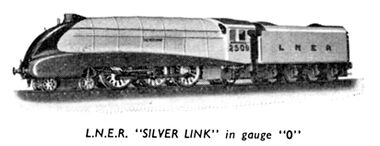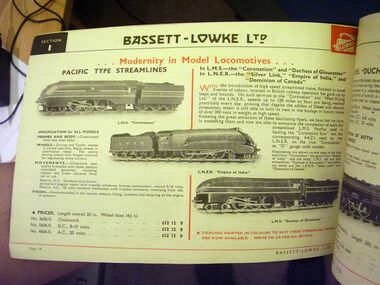Silver King locomotive LNER 2511 (Bassett-Lowke 4606)
| Exhibit |
|---|
Silver King locomotive LNER 2511 (Bassett-Lowke 4606) (i) (i)
|
 |
| location: |
|
Arch Three , Area 63 1936 |
October 1936: general B-L advert in Meccano Magazine, featuring the Silver Link model [image info]
December 1936: Silver Link locos in the B-L "Model Railways" catalogue.
Note the high initial price of £16-16. [image info]
November 1937: Bassett-Lowke Silver Link [image info]
1937: B-L streamline locomotives in gauge 0. Silver Link has now been displaced from the illustrations by the blue "Empire of India", mentioning the Silver Link as also available (but not illustrated).
Note the the uniform price for all the streamliners, in all their versions, has now dropped to £12-12 ... three-quarters of the original asking price for the "Silver" A4 models the previous year [image info]
A 1936 Bassett-Lowke 20V AC gauge 0 model of one of the LNER's four streamlined flagship A4 "Silver Streak" locomotives. Bassett-Lowke advertised these as "Silver Link" locomotives (referring to the first, 2509), but could supply them marked up as either 2509 Silver Link, 2510 Quicksilver, 2511 Silver King, or 2512 Silver Fox. This example carries the markings of 2511 Silver King.
The original locomotive
The A4 series represented the LNER's foray into streamlining, the most famous example nowadays being 4468 Mallard (1938), which earned the world speed record for a steam locomotive.
However, before Mallard's fame eclipsed that of the earlier A4s, the most famous A4 locos were the first four produced, number 2509 to 2512, and known as the "Silver Streaks". These were finished in three shades of grey and hauled the special Silver Jubilee train, which had articulated pairs of carriages sharing a common central bogie to give a smoother, quieter ride, and whose exteriors were finished in silver.
The model
This particular Bassett-Lowke model is also rather special, in that, although the model was in the company catalogues for some years, and is/was highly desirable, the high cost of the model combined with the fact that the LNER changed the default livery for new A4s after only perhaps a year or two, meant that very few were ever sold.
Bassett-Lowke only seems to have ever made a single batch of six of these models, and this example is the very first of the batch (number 1 of 6). This probably makes this particular model the first commercial (i.e. not special-order) gauge 0 streamliner model produced by or for Bassett-Lowke.
The four "silver" A4s and their silver trains had been meant to be a celebration of the 1935 Silver Jubilee of King George V, who had then been inconsiderate enough to die in January 1936. Changing tack, the LNER quickly switched all further A4s to a different colour scheme, and maintained a royal connection by finishing these in "garter blue" and having them haul a new train, "The Coronation" (whose carriages were still based on the twin-articlated-coach "Silver Jubilee" design, but were now finished externally in teak rather than silver) to reference the 1936 coronation of the new King, Edward VIII. Edward VIII then abdicated in December of the same year, and was succeeded by King George VI ... which meant another coronation. Since the name hadn't been specific as to which coronation was being referred to, this naming and colour scheme lasted rather longer than the silver.
Because the "Silver" theme and livery were replaced so quickly, it meant that even if someone in 1937 had the money to buy a top-of-the-range Bassett-Lowke locomotive, and opted to buy some sort of A4, their first choice would now be either the more up-to-date blue 4490 "Empire of India" or a the blue 4489 "Dominion of Canada" rather than the grey "Silver Link". Further competition for the Bassett-Lowke customer's wallet was provided by the brand new streamlined LMS 6220 Coronation in blue and silver, and the red and gold LMS 6225 Duchess of Gloucester. The Silver Link therefore rapidly went from being the first of Britain's first and only streamlined locomotive class, with radical styling and the sort of colour scheme that had never been seen before, to being one of two competing streamlined classes, and having a name that irretrievably associated the locomotive with what was now an obsolete livery celebrating a deceased king. The loco's stylimg and naming went from being "state of the art" to "old-fashioned" incredibly quickly, a decline that wasn't helped by Mallard's subsequent breaking of the speed record, again showing the garter-blue livery.
An enthusiast would of course want all of them, but at over twelve pounds each, buying one of each was not an option for many people!
1936 promotional text
BASSETT-LOWKE LTD. SCALE MODEL L.N.E.R. STREAMLINED 4-6-2 LOCOMOTIVE No. 2509 "SILVER LINK" CLOCKWORK AND ELECTRIC GAUGE No "0"
RAILWAY history has been made by the London & North Eastern Railway in the introduction of their "Silver Jubilee" Express between London and Newcastle. It is the first fully streamlined train to run in Great Britain ; and it is the first train in the world to make a double daily non-stop run of over 200 miles in length at an average speed of over 70 miles an hour. The "Silver Jubilee" leaves Newcastle-on-Tyne at 10 a.m., and is due at King's Cross, 268.3 miles away, at 2 p.m., having covered the 232.3 miles from Darlington in 198 minutes, at 70.3 miles an hour. On the return journey London is left at 5.30 p.m., and with the same intermediate timings. Newcastle is reached 4 hours later, a gain of over an hour on the fastest timing by any other service. The locomotives are designed on the same general lines as the other L.N.E.R. "Pacifics", save for having slightly smaller cylinders, larger piston-valves and a steam pressure of 250 pounds per square inch, and more ample steam passages, together with the superbly designed streamline covering which undoubtedly has been of considerable assistance in maintaining high speeds. Normally the schedule demands an average of almost exactly 75 miles an hour over the 157 miles between Hatfield and Selby, involving maxima up to and exceeding 90 miles an hour, and sustained speeds of 70 miles an hour and over up to 1 in 200 gradients. World records were made by the "Silver Link" on a trial trip on September 28th, 1935, when 43 miles were covered at an average speed of 100 miles an hour, and a maximum speed of 112½ miles an hour was twice attained. This accurate model brings out all the salient points of its record-breaking prototype, and is a most interesting and unique addition to the model railway.
SPECIFICATION OF MODEL
- FRAMES AND BODY. — Constructed from Welsh Tinned Steel Plate.
- WHEELS. — Driving and Tender Wheels in turned cast-iron, Bogie Wheels in anti-friction metal. The centre driving wheel with flanges removed for negotiating sharp corners.
- C/W MOVEMENT. — Best quality six-coupled with latest pattern controlled governor, reversing motion and brake both actuated from the rail or cab.
- ELECTRIC D.C. — Standard Spur-driven Permag. six-coupled Motor tripolar armature, bronze commutator, wound 8-10 volts.
- ELECTRIC A.C. – 20 volts standard mechanism with tripolar armature, reversing from cab.
- FINISH. – The whole Engine hand-enamelled in the correct colours, lining, numbers and lettering.
- No. 2507/0. C/W Model. Length overall 20 in., wheel base 16¾ in.... ... ... PRICE £16 16 0
- No. 5606/0. D.C. Model. 8-10 volts. ditto ... ... ... ... ... £16 16 0
- No. 4606/0. A.C. Model. 20 volts, ditto ... .... ... ... ... ... £16 16 0
"Quicksilver" No. 2510, "Silver King" No. 2511 and "Silver Fox" No. 2512 can be supplied without extra charge.
— , Bassett-Lowke, , B-L Model Railway Catalogue, , December 1936
Construction
This model of 2509 Silver Link has the original unretouched factory paintwork.
One question that obviously comes up on the subject of this model is that – if the grey B-L A4 is now so much rarer and more desirable than the more common "blue" A4 version, then what's to stop someone acquiring a blue "Empire" or "Dominion" A4 loco and repainting it?
Although we know of at least one blue-to-grey "repaint" in existence, the result isn't entirely authentic, as the two sets of models were not simply the same model with different paintowrk – the construction and design of Bassett-Lowke's later "blue" A4 models was actually different to that of the first six. For instance, while the blue B-L A4s used some brass parts for parts of the loco nose, the front of the "grey" models are fabricated from steel, and the bodyshapes and detailing are also subtly different. This means that one can't "fake" a B-L Silver Link model by stripping and reworking a different B-L A4 ... at least, not in any way that would fool an expert collector.
Rarity
Our Silver Link "number one of six" has survived in impeccable condition.
We don't know how many of the other five still exist, or even whether all of them were sold, or whether (if they weren't selling) some might have been scrapped and turned into blue A4s. While this might be the only surviving example, we feel that it's more probable that someowhere out there, a collector has another one safely tucked away in their basement.
For the Bassett-Lowke enthusiast, though, this is probably going to be the only example that they will ever see.
Authentication
The chassis for the batch of six B-L "silvers" are each stamped with a number, 1-6. This was presumably so that the person working on the batch (with six sets of parts) could make sure that when details such as the running gear were adjusted for a specific one of the locos, it ended up being fitted to the correct one.
Our example is stamped as number one of the set. The first one of the batch is also normally assumed to be the prototype for all the rest, and since one of the batch will normally be selected as the version to be photographed, it is also normally the one that most care and attention is given to. In this case, we know that "number one" was not chosen as the example shown in the Bassett-Lowke publicity materials, as it has been marked up as 2511 Silver King, and the publicity example whose photo is in the catalogues is 2509 Silver Link. We think that what might have happened here is that the builder might have improved on their technique slightly after finishing #1, and chosen a different loco as "the best" to letter up as 2509 and use for photographs, with at least three of the other locos (including #1) then being assigned the other numbers and names, so that B-L would initially have been able to supply any of the four variations directly from stock.
External links
- Arch Three
- Exhibits
- 1930s Layout, goods side
- 1936
- 1930s
- Inter-War
- Earlier Twentieth Century
- C20th
- London and North Eastern Railway
- 4-6-2
- Locos by digits
- Locos by number
- 1930s locomotives
- Locomotives by date
- Locomotives and trains
- Silver Link
- A4 Class locomotives
- Streamlined locomotives and trains
- The Silver Jubilee (train)
- Streamlining
- Bassett-Lowke Ltd
- Bassett-Lowke gauge 0
- 2021 - new exhibits and infrastructure







